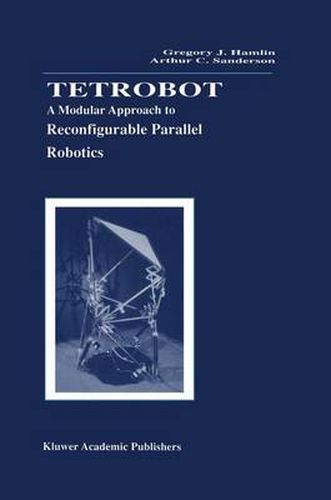Readings Newsletter
Become a Readings Member to make your shopping experience even easier.
Sign in or sign up for free!
You’re not far away from qualifying for FREE standard shipping within Australia
You’ve qualified for FREE standard shipping within Australia
The cart is loading…






This title is printed to order. This book may have been self-published. If so, we cannot guarantee the quality of the content. In the main most books will have gone through the editing process however some may not. We therefore suggest that you be aware of this before ordering this book. If in doubt check either the author or publisher’s details as we are unable to accept any returns unless they are faulty. Please contact us if you have any questions.
Robotic systems are characterized by the intersection of computer intelligence with the physical world. This blend of physical reasoning and computational intelligence is well illustrated by the Tetrobot study described in this book.
Tetrobot: A Modular Approach to Reconfigurable Parallel Robotics describes a new approach to the design of robotic systems. The Tetrobot approach utilizes modular components which may be reconfigured into many different mechanisms which are suited to different applications. The Tetrobot system includes two unique contributions: a new mechanism (a multilink spherical joint design), and a new control architecture based on propagation of kinematic solutions through the structure. The resulting Tetrobot system consists of fundamental components which may be mechanically reassembled into any modular configuration, and the control architecture will provide position control of the resulting structure.
A prototype Tetrobot system has been built and evaluated experimentally. Tetrobot arms, platforms, and walking machines have been built and controlled in a variety of motion and loading conditions.
The Tetrobot system has applications in a variety of domains where reconfiguration, flexibility, load capacity, and failure recovery are important aspects of the task.
A number of key research directions have been opened by the Tetrobot research activities. Continuing topics of interest include: development of a more distributed implementation of the computer control architecture, analysis of the dynamics of the Tetrobot system motion for improved control of high-speed motions, integration of sensor systems to control the motion and shape of the high-dimensionality systems, and exploration of self-reconfiguration of the system.
Tetrobot: A Modular Approach to Reconfigurable Parallel Robotics will be of interest to research workers, specialists and professionals in the areas of robotics, mechanical systems and computer engineering.
$9.00 standard shipping within Australia
FREE standard shipping within Australia for orders over $100.00
Express & International shipping calculated at checkout
Stock availability can be subject to change without notice. We recommend calling the shop or contacting our online team to check availability of low stock items. Please see our Shopping Online page for more details.
This title is printed to order. This book may have been self-published. If so, we cannot guarantee the quality of the content. In the main most books will have gone through the editing process however some may not. We therefore suggest that you be aware of this before ordering this book. If in doubt check either the author or publisher’s details as we are unable to accept any returns unless they are faulty. Please contact us if you have any questions.
Robotic systems are characterized by the intersection of computer intelligence with the physical world. This blend of physical reasoning and computational intelligence is well illustrated by the Tetrobot study described in this book.
Tetrobot: A Modular Approach to Reconfigurable Parallel Robotics describes a new approach to the design of robotic systems. The Tetrobot approach utilizes modular components which may be reconfigured into many different mechanisms which are suited to different applications. The Tetrobot system includes two unique contributions: a new mechanism (a multilink spherical joint design), and a new control architecture based on propagation of kinematic solutions through the structure. The resulting Tetrobot system consists of fundamental components which may be mechanically reassembled into any modular configuration, and the control architecture will provide position control of the resulting structure.
A prototype Tetrobot system has been built and evaluated experimentally. Tetrobot arms, platforms, and walking machines have been built and controlled in a variety of motion and loading conditions.
The Tetrobot system has applications in a variety of domains where reconfiguration, flexibility, load capacity, and failure recovery are important aspects of the task.
A number of key research directions have been opened by the Tetrobot research activities. Continuing topics of interest include: development of a more distributed implementation of the computer control architecture, analysis of the dynamics of the Tetrobot system motion for improved control of high-speed motions, integration of sensor systems to control the motion and shape of the high-dimensionality systems, and exploration of self-reconfiguration of the system.
Tetrobot: A Modular Approach to Reconfigurable Parallel Robotics will be of interest to research workers, specialists and professionals in the areas of robotics, mechanical systems and computer engineering.